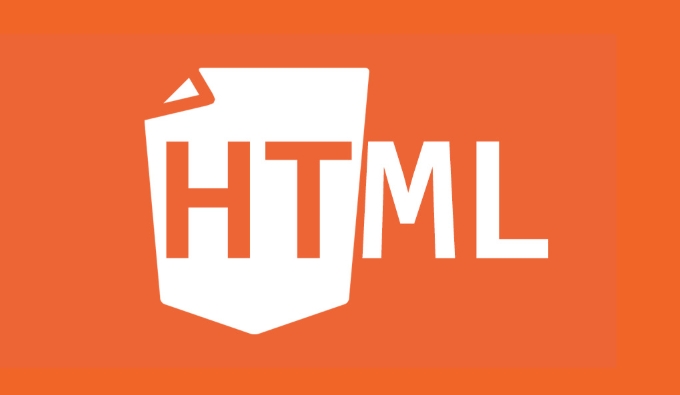How can I use HTML tags to improve web accessibility?
Jun 25, 2025 pm 06:07 PMThe core methods of using HTML tags to improve web accessibility include semanticizing HTML elements, adding alt text to images, correctly labeling form input, and creating meaningful link text. 1. Use semantic HTML elements (such as

Improving web accessibility with HTML tags is one of the most effective—and often overlooked—ways to make your website usable for everyone, including people with disabilities. You don't need fancy tools or extra plugins; just using the right HTML structure and semantics can go a long way.

Here's how to do it right:

Use Semantic HTML Elements
Semantic elements like <header></header> , <nav></nav> , <main></main> , <article></article> , and <footer></footer> help screen readers and other assistive technologies understand the structure of your page.
- Why it matters: Screen reader users can navigate by sections, skipping straight to the main content or jumping between articles.
- What to do: Replace generic
<div> or <code><span></span>tags with appropriate semantic tags where possible.- For example, use
<nav></nav>for navigation menus instead of just wrapping links in a<div class="nav"> .<p> This doesn't change how things look visually, but it makes a big difference for accessibility tools. </p> <img src="/static/imghw/default1.png" data-src="https://img.php.cn/upload/article/000/000/000/175084603718159.jpeg" class="lazy" alt="How can I use HTML tags to improve web accessibility?"><hr> <h3 id="Add-Alt-Text-to-Images-Using-code-alt-code-Attributes"> Add Alt Text to Images Using <code>altAttributesImages should always have descriptive
alttext so that screen readers can convey what the image shows.- Basic rule: If an image conveys information, describe it briefly in the
altattribute. - Exceptions: If the image is decorative (like background images or icons used for visual flair), use
alt=""to tell screen readers to skip it. - Example:
<img src="/static/imghw/default1.png" data-src="chart.png" class="lazy" alt="Bar chart showing monthly sales growth from January to December">
Avoid vague phrases like “image123” or leaving
altout entirely—that leaves users guessing or missing important context.Label Form Inputs Properly
Forms are tricky for many users if they aren't clearly labeled. Use the
<label>element paired with theforattribute matching the input'sid.- How it works:
<label for="email">Email Address</label> <input type="email" id="email" name="email">
- Benefits: Screen readers will read the label when the input is focused, helping users know what to enter.
- Bonus tip: Use
placeholdersparingly—it shouldn't replace a proper label since some users may not remember what the field was for once they start typing.
Also consider using
aria-describedbyfor longer descriptions or validation hints.Make Links Descriptive and Meaningful
Avoid vague link texts like “click here” or “read more.” Instead, use clear, describe text that explains where the link goes.
- Bad example:
<a href="/contact">Click here</a> to get in touch.
- Better example:
<a href="/contact">Contact our support team</a>
Screen readers sometimes list all links on a page, so meaningful link text helps users decide where to go without reading surrounding context.
Using HTML properly isn't complicated, but it has a huge impact on accessibility. These practices are easy to adopt and often improve SEO and maintainability too. Basically, it comes down to writing clean, meaningful code that reflects the actual purpose of each element.
- Basic rule: If an image conveys information, describe it briefly in the
- For example, use
The above is the detailed content of How can I use HTML tags to improve web accessibility?. For more information, please follow other related articles on the PHP Chinese website!

Hot AI Tools

Undress AI Tool
Undress images for free

Undresser.AI Undress
AI-powered app for creating realistic nude photos

AI Clothes Remover
Online AI tool for removing clothes from photos.

Clothoff.io
AI clothes remover

Video Face Swap
Swap faces in any video effortlessly with our completely free AI face swap tool!

Hot Article

Hot Tools

Notepad++7.3.1
Easy-to-use and free code editor

SublimeText3 Chinese version
Chinese version, very easy to use

Zend Studio 13.0.1
Powerful PHP integrated development environment

Dreamweaver CS6
Visual web development tools

SublimeText3 Mac version
God-level code editing software (SublimeText3)
 The `` vs. `` in HTML
Jul 19, 2025 am 12:41 AM
The `` vs. `` in HTML
Jul 19, 2025 am 12:41 AM
It is a block-level element, used to divide large block content areas; it is an inline element, suitable for wrapping small segments of text or content fragments. The specific differences are as follows: 1. Exclusively occupy a row, width and height, inner and outer margins can be set, which are often used in layout structures such as headers, sidebars, etc.; 2. Do not wrap lines, only occupy the content width, and are used for local style control such as discoloration, bolding, etc.; 3. In terms of usage scenarios, it is suitable for the layout and structure organization of the overall area, and is used for small-scale style adjustments that do not affect the overall layout; 4. When nesting, it can contain any elements, and block-level elements should not be nested inside.
 Specifying Character Encoding for HTML Documents (UTF-8)
Jul 15, 2025 am 01:43 AM
Specifying Character Encoding for HTML Documents (UTF-8)
Jul 15, 2025 am 01:43 AM
To correctly set the character encoding of the HTML document to UTF-8, you need to follow three steps: 1. Add at the top of the HTML5 part; 2. Configure the response header Content-Type: text/html; charset=UTF-8, if Apache uses AddDefaultCharsetUTF-8, Nginx uses charsetutf-8; 3. Select the UTF-8 encoding format when saving HTML files in the editor. These three links are indispensable, otherwise it may lead to garbled page code and failure of special character parsing, affecting user experience and SEO effect. It is important to ensure that HTML declaration, server configuration and file saving are consistent.
 Essential HTML Tags for Beginners
Jul 27, 2025 am 03:45 AM
Essential HTML Tags for Beginners
Jul 27, 2025 am 03:45 AM
To get started with HTML quickly, you only need to master a few basic tags to build a web skeleton. 1. The page structure is essential, and, which is the root element, contains meta information, and is the content display area. 2. Use the title. The higher the level, the smaller the number. Use tags to segment the text to avoid skipping the level. 3. The link uses tags and matches the href attributes, and the image uses tags and contains src and alt attributes. 4. The list is divided into unordered lists and ordered lists. Each entry is represented and must be nested in the list. 5. Beginners don’t have to force memorize all tags. It is more efficient to write and check them while you are writing. Master the structure, text, links, pictures and lists to create basic web pages.
 Shadow DOM Concepts and HTML Integration
Jul 24, 2025 am 01:39 AM
Shadow DOM Concepts and HTML Integration
Jul 24, 2025 am 01:39 AM
ShadowDOM is a technology used in web component technology to create isolated DOM subtrees. 1. It allows the mount of an independent DOM structure on ordinary HTML elements, with its own styles and behaviors, and does not affect the main document; 2. Created through JavaScript, such as using the attachShadow method and setting the mode to open; 3. When used in combination with HTML, it has three major features: clear structure, style isolation and content projection (slot); 4. Notes include complex debugging, style scope control, performance overhead and framework compatibility issues. In short, ShadowDOM provides native encapsulation capabilities for building reusable and non-polluting UI components.
 Why is my image not showing up in HTML?
Jul 28, 2025 am 02:08 AM
Why is my image not showing up in HTML?
Jul 28, 2025 am 02:08 AM
Image not displayed is usually caused by a wrong file path, incorrect file name or extension, HTML syntax issues, or browser cache. 1. Make sure that the src path is consistent with the actual location of the file and use the correct relative path; 2. Check whether the file name case and extension match exactly, and verify whether the image can be loaded by directly entering the URL; 3. Check whether the img tag syntax is correct, ensure that there are no redundant characters and the alt attribute value is appropriate; 4. Try to force refresh the page, clear the cache, or use incognito mode to eliminate cache interference. Troubleshooting in this order can solve most HTML image display problems.
 HTML `style` Tag: Inline vs. Internal CSS
Jul 26, 2025 am 07:23 AM
HTML `style` Tag: Inline vs. Internal CSS
Jul 26, 2025 am 07:23 AM
The style placement method needs to be selected according to the scene. 1. Inline is suitable for temporary modification of single elements or dynamic JS control, such as the button color changes with operation; 2. Internal CSS is suitable for projects with few pages and simple structure, which is convenient for centralized management of styles, such as basic style settings of login pages; 3. Priority is given to reuse, maintenance and performance, and it is better to split external link CSS files for large projects.
 Can you put a tag inside another tag?
Jul 27, 2025 am 04:15 AM
Can you put a tag inside another tag?
Jul 27, 2025 am 04:15 AM
?Youcannotnesttagsinsideanothertagbecauseit’sinvalidHTML;browsersautomaticallyclosethefirstbeforeopeningthenext,resultinginseparateparagraphs.?Instead,useinlineelementslike,,orforstylingwithinaparagraph,orblockcontainerslikeortogroupmultipleparagraph
 HTML `link` for Prefetching DNS
Jul 23, 2025 am 02:19 AM
HTML `link` for Prefetching DNS
Jul 23, 2025 am 02:19 AM
Pre-resolving DNS can speed up page loading speed, and using HTML link tags for DNS pre-resolving is an effective method; DNSPrefetching saves subsequent request time by resolving domain names in advance; applicable scenarios include third-party fonts, advertising statistics scripts, resource hosting and CDN domain names; it is recommended to prioritize the main page dependency resources, reasonably control the number between 3 and 5, and use it with preconnect to better effect.






